Syrian cuisine
This article needs additional citations for verification. (May 2015) |
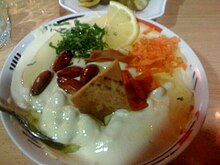


Syrian cuisine may refer to the cooking traditions and practices in modern-day Syria (as opposed to Greater Syria), merging the habits of people who settled in Syria throughout its history.
Syrian cuisine mainly uses eggplant, zucchini, garlic, meat (mostly from lamb, mutton, sesame seeds, rice, chickpeas, fava beans, lentils, cabbage, cauliflower, vine leaves, pickled turnips, cucumbers, tomatoes, olive oil, lemon juice, mint, pistachios, honey and fruits.
At the beginning of the 21st century, selections of appetizers known as "meze" are customarily served along with Arabic bread before the Syrian meal's main course, which is followed by coffee, with sweet confectioneries and/or fruits at will. Many recipes date from at least the 13th century.[1]
Foods
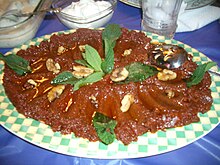
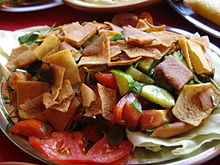

Meze
Meze include:
| Name | Description |
|---|---|
| Fatteh (فتّة) | Pieces of Arabic bread covered with other ingredients. |
| Fatteh bi-s-samn (فتّة بالسمن) | Fatteh made with beef or sheep tallow. |
| Fatteh bi-z-zayt (فتّة بالزيت) | Fatteh made with vegetable, corn, or olive oil. |
| Fatteh al-makdus (فتّة المكدوس) | Fatteh with makdus and minced meat. |
| Fatteh dajaj (فتّة دجاج) | Fatteh with chicken. |
| Fatteh bi-l-lahm (فتّة باللحم) | Fatteh with meat. |
| Makdus (مكدوس) | Stuffed and pickled eggplants. |
| Muhammarah (محمرة) | A hot pepper dip from Aleppo,[2] made from Aleppo pepper. |
| Shanklish (شنكليش) | Cheese. |
Vine leaves
| Name | Description |
|---|---|
| Yabra' (يبرق) | Vine leaves stuffed with rice and minced meat cooked and served hot. |
| Yalanji | Vine leaves stuffed with rice and a variety of vegetables and served hot or cold. |
Kebab
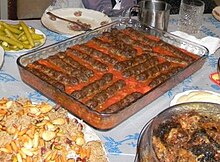
| Name | Description |
|---|---|
| Kebab (كباب) | Grilled meat. |
| Kebab Halabi (كباب حلبي meaning "Aleppine kebab") | Kebab served with a spicy tomato sauce and Aleppo pepper. It has about 26 variants,[3] including:
|
Kubbeh
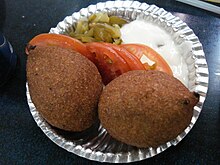
A variety of Syrian dishes made from a fried, baked, grilled, cooked, or raw mixture of bulghur and minced lamb are called "kubbeh" (كبّة). Kubbeh recipes include:
| Name | Description |
|---|---|
| Kubbeh bi-s-siniyyeh (كبّة بالصينيّة meaning "plate kubbeh") | A plate of baked kubbeh. |
| Kubbeh Halab (كبّة حلب) | Kubbeh with a rice crust. Although named after Aleppo, this recipe seems to be of Iraqi origin. |
| Kubbeh hamid (كبّة حامض) | Kubbeh with lemon juice. |
| Kubbeh labaniyyeh (كبّة لبنيّة) | Cooked kubbeh with yogurt. |
| Kubbeh 'qras (كبّة أقراص meaning "disc kubbeh") | Grilled kubbeh. |
| Kubbeh nayyeh (كبّة نيّة) | Raw kubbeh. |
| Kubbeh safarjaliyyeh (كبّة سفرجليّة) | Kubbeh with quince. |
| Kubbeh summa'iyyeh (كبّة سمّاقيّة) | Kubbeh with sumac. |
Mahshi

A famous dish served in Syria is made from vegetables (usually zucchini—كوسا / kūsā—or eggplant—باذنجان / bādhinjān) which are stuffed (محشي / maḥshī) with ground beef or lamb or mutton, and nuts and rice.
Street food
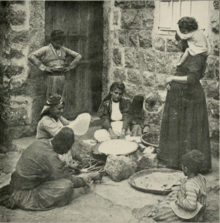


Syrian street food includes:
| Name | Description |
|---|---|
| Falafil (فلافل) | Fried balls or patties of spiced, mashed chickpeas, most often served in Arabic bread, with pickles, tahina, hummus, sumac, cut vegetable salad and often, shatteh, a hot sauce, the type used depending on the falafil maker. |
| Ka'ak (كعك) | Rings of bread, made from farina and other ingredients, commonly sprinkled with sesame seeds, occasionally served on the table to accompany Syrian cheese. A buttery and sweetened version of these, filled with crushed dates or walnuts, is eaten as a dessert, usually served to eat with string cheese shaped into a braid (jibneh mashallaleh). |
| Shawarma (شاورما) | Sliced and marinated meat shaved off a roasting skewer and stuffed into Arabic bread or sometimes baguette, alone with hummus, or with additional trimmings such as fresh onion, French fries, salads and pickles. |
Sweets


Sweets include:
| Name | Description |
|---|---|
| Ba'lawah (بقلاوة) | Layered pastry filled with nuts, steeped in a honey syrup called "'atr" (قطر), and usually cut in a triangular or diamond shape. |
| Basbousa (بسبوسة) | A sweet cake made of cooked semolina or farina soaked in simple syrup. |
| Ghazal al-banat (غزل البنات) | Sugar cotton candy stuffed with pistachios or cashew. |
| Halaweh Homsiyyeh (حلاوة حمصيّة) | |
| Halawet al-jibn (حلاوة الجبن) | Pastry rolled and stuffed with cheese or thick milk cream, served with a honey syrup called "'atr" (قطر). |
| Halweh (حلوة) | A slab of sesame paste studded with fruit and candy/sweets. |
| Kanafeh (كنافة) | Shoelace pastry dessert stuffed with sweet white cheese, nuts and syrup. |
| Ma'mul (معمول) | Biscuits filled with dates, pistachios or walnuts, and shaped in a wooden mould called "tabi'" (طابع). It is a popular sweet on Christian holidays (Easter), Muslim holidays ('Id al-Fitr), and Jewish holidays (Purim). |
| Mamuniyyeh (مامونيّة) | Mixture of semolina and ghee butter simmered in water with sugar, usually served with salty cheese or milk cream called "qishteh" (قشطة). |
| Nabulsiyyeh (نابلسيّة) | A layer of semi-salty Nabulsi cheese covered with a semolina dough and drizzled with a honey syrup called "'atr" (قطر). |
| Qada'ef (قطايف) | Semolina dough stuffed with a paste made from sweet walnuts or milk cream, with a honey syrup called "'atr" (قطر). |
| Qamar ad-din (قمر الدين) | Dried apricot paste. |
| Suwar as-sitt (سوار الست meaning "lady's wristlet") | A disc-shaped pastry steeped in a honey syrup called "'atr" (قطر) while the centre is covered with smashed pistachios. |
| Taj al-malik (تاج الملك meaning "king's crown") | Round dry pastry, the centre of which is filled with pistachios, cashews or other nuts. |
| Zilabiyyeh (زلابيّة) | Thin sheets of semolina dough, boiled, rolled and stuffed with pistachios or milk cream called "qishteh" (قشطة). |
| Znud as-sitt (زنود الست meaning "lady's arms") | Phyllo pastries with various fillings. |
Cheeses
Tresse cheese is a form of string cheese, known by its Arabic name, Jibneh Mshallaleh , that originates in Syria, as does Jibne Khadra. See also Syrian cheese.
Beverages

| Name | Description |
|---|---|
| Arabic coffee (قهوة عربيّة) | A beverage made from lightly roasted coffee beans along with cardamom, and served with dates, dried fruit and nuts. |
| 'Ara' (عرق) | A distilled alcoholic spirit, transparent in color, made from anise seeds. |
| 'Ayran (عيران) | A yogurt-based beverage mixed with salt and water. |
| Jallab (جلاب) | A fruit syrup which can be combined with liquid to form a hot or warm beverage. |
| Al-mateh (المته) | A caffeine-infused drink produced from ground yerba mate leaves and served hot. |
| Polo (بولو) | Mint lemonade. |
| Syrian beer (البيرة السوريّة) | A beverage prepared from yeast-fermented malt, flavored with hops. |
| Qahweh bayda' (قهوة بيضاء meaning "white coffee") | A caffeine-free drink made from water and orange blossom water, sweetened with sugar at will, usually served in lieu of coffee. |
| Wine (خمر) | An alcoholic beverage made from fermented grapes. |
See also
References
- ^ Eddé, Anne-Marie. (1999). La Principauté ayyoubide d'Alep (579/1183 – 658/1260).
- ^ The Culinary Institute of America (2008). Garde Manger: The Art and Craft of the Cold Kitchen (Hardcover ed.). Wiley. p. 53. ISBN 0-470-05590-1.
- ^ "كونا :: المطبخ الحلبي ينفرد بتنوع اطعمته وطيب نكته 11/01/2006". kuna.net.kw.
Further reading
- Gerbino, Virginia Jerro; Kayal, Philip (2002). A taste of Syria. New York: Hippocrene. ISBN 9780781809467.
- Kadé-Badra, Dalal; Badra, Elie (2013). Flavours of Aleppo : celebrating Syrian cuisine. Vancouver, Canada: Whitecap Books. ISBN 9781770501782.
External links
![]() Media related to Cuisine of Syria at Wikimedia Commons
Media related to Cuisine of Syria at Wikimedia Commons
